Refine search
Actions for selected content:
4656 results in Archaeological Theory and Methods
Innovation's Heritage
- Insights on a Cultural Phenomenon from the Ancient Past
- Coming soon
-
- Expected online publication date:
- July 2026
- Print publication:
- 31 July 2026
-
- Book
- Export citation

The Archaeology of the Tibetan Plateau
- Coming soon
-
- Expected online publication date:
- April 2026
- Print publication:
- 30 April 2026
-
- Book
- Export citation

Analytical Chemistry in Archaeology
- Coming soon
-
- Expected online publication date:
- March 2026
- Print publication:
- 31 March 2026
-
- Book
- Export citation

Zooarchaeology
- Coming soon
-
- Expected online publication date:
- January 2026
- Print publication:
- 18 December 2025
-
- Textbook
- Export citation
Materializing a Gendered Colonial Worldview: Symbolic Permeability in Votive Offerings in the Roman Northwest
-
- Journal:
- Cambridge Archaeological Journal , First View
- Published online by Cambridge University Press:
- 23 December 2025, pp. 1-15
-
- Article
-
- You have access
- Open access
- HTML
- Export citation
Traces of Clay: Exploring Slave and Migrant Identities in Medieval Swahili Zanzibar
-
- Journal:
- Cambridge Archaeological Journal , First View
- Published online by Cambridge University Press:
- 22 December 2025, pp. 1-14
-
- Article
-
- You have access
- Open access
- HTML
- Export citation
‘There are no two similar kinds of reindeer. You have to be with the reindeer to learn.’ The Variety of Life among Ancient Sámi Reindeer Herders
-
- Journal:
- Cambridge Archaeological Journal , First View
- Published online by Cambridge University Press:
- 22 December 2025, pp. 1-14
-
- Article
-
- You have access
- Open access
- HTML
- Export citation
Memory Work in Mud, Stone and Wood: Material Knowledges in Turbulent Times in Southern Africa
-
- Journal:
- Cambridge Archaeological Journal , First View
- Published online by Cambridge University Press:
- 17 December 2025, pp. 1-16
-
- Article
-
- You have access
- Open access
- HTML
- Export citation
Living Monumentality: The Socio-political Landscapes of Big Buddha Statues (dafo 大佛) in Southern Sichuan, China (700–1200 ce)
-
- Journal:
- Cambridge Archaeological Journal , First View
- Published online by Cambridge University Press:
- 15 December 2025, pp. 1-18
-
- Article
-
- You have access
- Open access
- HTML
- Export citation
Farewell to Behavioural Modernity? Homo sapiens in the Middle Stone Age
-
- Journal:
- Cambridge Archaeological Journal , First View
- Published online by Cambridge University Press:
- 12 December 2025, pp. 1-13
-
- Article
-
- You have access
- Open access
- HTML
- Export citation
The Artistic Nature of the Chinchorro Mummies and the Archaeology of Grief
-
- Journal:
- Cambridge Archaeological Journal , First View
- Published online by Cambridge University Press:
- 27 November 2025, pp. 1-18
-
- Article
-
- You have access
- Open access
- HTML
- Export citation
Identities in Practice: The Fixity and Fluidity of Signs of Belonging in Ancient and Modern Britain
-
- Journal:
- Cambridge Archaeological Journal , First View
- Published online by Cambridge University Press:
- 25 November 2025, pp. 1-11
-
- Article
-
- You have access
- Open access
- HTML
- Export citation
Making Absence Present: Subaltern Identities in Punic and Roman Period Sardinia
-
- Journal:
- Cambridge Archaeological Journal , First View
- Published online by Cambridge University Press:
- 24 November 2025, pp. 1-16
-
- Article
-
- You have access
- Open access
- HTML
- Export citation
Affective Politics and the Qualities of Things: Materials and Metonymy in the Archaeology of Highland Madagascar
-
- Journal:
- Cambridge Archaeological Journal , First View
- Published online by Cambridge University Press:
- 21 November 2025, pp. 1-13
-
- Article
-
- You have access
- Open access
- HTML
- Export citation
Semioidentity: Archaeological Perspectives on the Meaning of Things
-
- Journal:
- Cambridge Archaeological Journal , First View
- Published online by Cambridge University Press:
- 20 November 2025, pp. 1-8
-
- Article
-
- You have access
- Open access
- HTML
- Export citation
Semiotic Identities in Archaeology: The Politics of Interpretation Introduction to Archaeological Identitiscapes: A Semiotic Stance
-
- Journal:
- Cambridge Archaeological Journal , First View
- Published online by Cambridge University Press:
- 19 November 2025, pp. 1-9
-
- Article
-
- You have access
- Open access
- HTML
- Export citation
Evolutionary Cognitive Archaeology and Acheulean Technology. A Historiographic Review
-
- Journal:
- Cambridge Archaeological Journal / Volume 35 / Issue 4 / November 2025
- Published online by Cambridge University Press:
- 10 November 2025, pp. 633-647
-
- Article
-
- You have access
- Open access
- HTML
- Export citation
The Order of Things: Saunas as Performative Places in Northwestern Iberia during the Late Iron Age
-
- Journal:
- Cambridge Archaeological Journal , First View
- Published online by Cambridge University Press:
- 05 November 2025, pp. 1-15
-
- Article
-
- You have access
- Open access
- HTML
- Export citation
Livestock and the Transition to the Tributary Mode of Production
-
- Journal:
- Cambridge Archaeological Journal , First View
- Published online by Cambridge University Press:
- 04 September 2025, pp. 1-16
-
- Article
-
- You have access
- Open access
- HTML
- Export citation
Turning-the-edge, Tranchet, and Social Signalling at Boxgrove
-
- Journal:
- Cambridge Archaeological Journal , First View
- Published online by Cambridge University Press:
- 04 September 2025, pp. 1-18
-
- Article
-
- You have access
- Open access
- HTML
- Export citation
